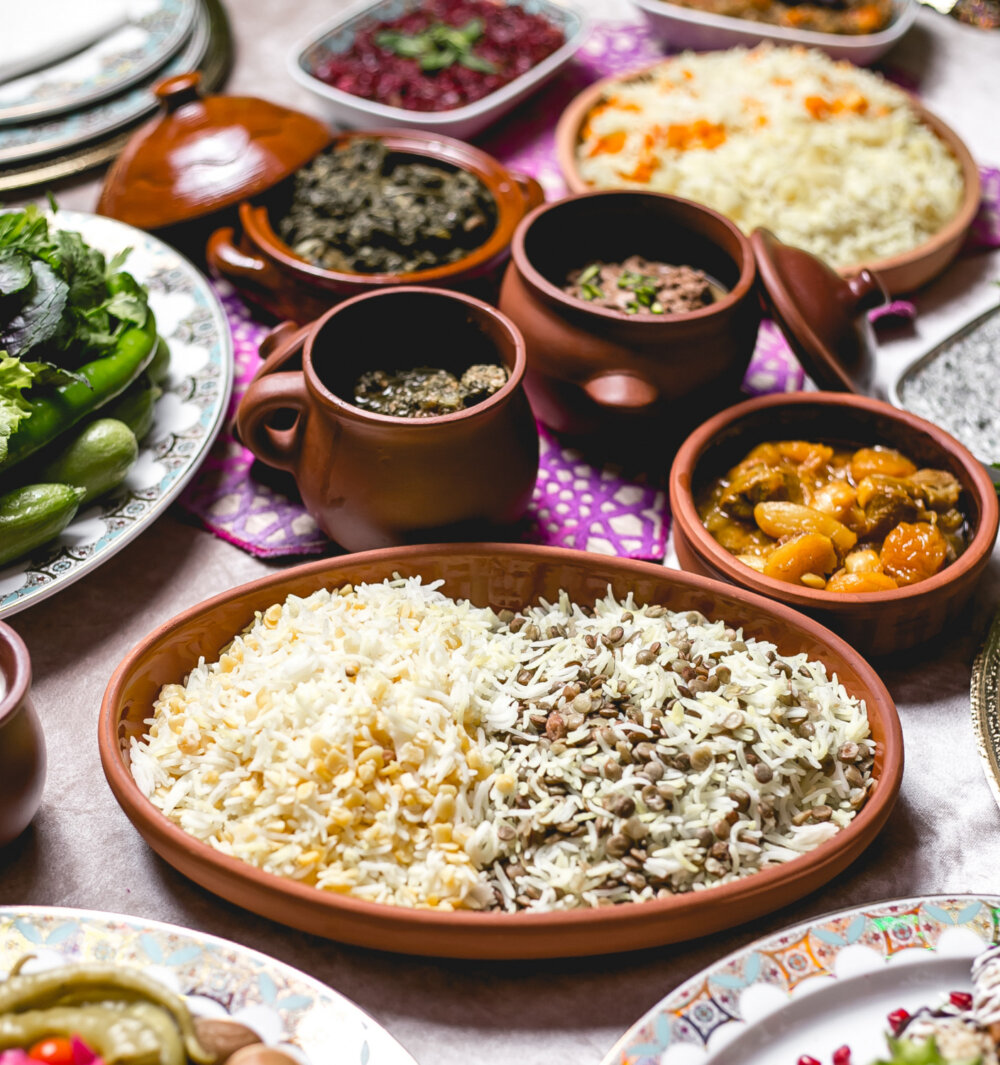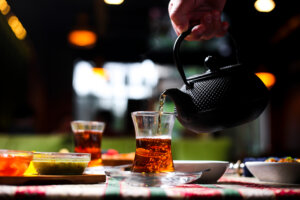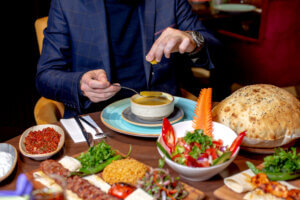At midday in my village, the sun tips its shimmering bowl over the paddy fields, and kitchens come alive like small orchestras. Oil warms with a soft hiss, mustard seeds pop like tiny fireworks, and a handful of curry leaves crackles in the pan, releasing a forest-green perfume that drifts through doorways and down red-dusted lanes. Pots of rice breathe steam—white or brick-red grains—while clay vessels murmur on the hearth, thickening coconut milk into gravies the color of turmeric and moonlight. This is rice and curry, our island’s daily poetry. It is not one dish but a conversation: rice piled at the center, surrounded by a chorus of curries—spicy, sour, rich, and herbal—each flavor tugging at another until the plate tells a story older than the salt breeze.
I grew up eating that story with my fingers, mixing with the right hand until warmth, spice, and grain became one mouthful. Every family carries its verses, every province a dialect: Jaffna’s fire and coastal sourness, upcountry gentleness and eastern sea-breath. To understand Sri Lanka, follow the spoon—or better, your fingertips—into rice and curry. Let me take you there.
From Past to Plate
Our story begins in water. Sri Lanka’s ancient kings braided the land with reservoirs—tanks so wide they catch the sky—so rice could ripple across the plains. The harvest wasn’t just food; it was ceremony, thanksgiving sung in chanted verses, palms lifted to sun and rain. Rice, our staple, is the island’s heartbeat. Curry arrived as a companion, shaped by spice winds and wandering traders: cinnamon gathered from low-country forests, black pepper from the hills, chilies arriving later by sea. Coconut milk softened the heat, goraka (the smoky-sour fruit of the rainforest) preserved fish through monsoon and made it sing in the south.
Over centuries, our kitchens became crossroads. Tamil homes in the north roasted spices to a dusky red, building deep, earthy gravies that cling to the tongue. Moor families folded in fragrant fennel and cardamom, while Malay influences introduced tang and layered spice to celebratory feasts. In the hills around Kandy, where mornings are mist and tea-bud green, curries turned lighter, the comfort of kiri hodi—coconut-milk broth—nestling against a heap of steaming rice. Each region learned to cook with what it could coax from soil and sea, weaving necessity into flavor until it tasted like belonging.
Ingredients or Key Elements
Sri Lankan rice and curry is a constellation of essentials—some staple, some seasonal, all expressive of place:
- Rice: From delicate samba to sturdy nadu and nutty red “rathu haal,” the grain sets the stage. Up north, long grains appear, while in the south red rice gives a hearty, mineral bite.
- Coconut: Grated, pressed into milk, or toasted into blackened “kalupol” pastes; the palm is both pantry and poetry.
- Spices & aromatics: Mustard seeds, cumin, coriander, fennel, black pepper, turmeric, cinnamon, cloves, cardamom; fresh lemongrass, pandan (rampe), curry leaves, garlic, ginger, onions.
- Heat & color: Dried red chilies for depth, fresh green for brightness, and roasted Jaffna curry powder that smolders with personality.
- Sour soul: Goraka lends smoky tartness to southern fish; tamarind brightens eastern seafood; lime finishes many a curry with a sunny kiss.
- Vegetables & greens: Jackfruit three ways—baby “polos,” young “kos,” and ripe “waraka”—plus bitter gourd, pumpkin, drumstick, banana blossom, and quick-sautéed mallung of shredded leaves and coconut.
- Proteins of place: Lagoon crab in the east, mutton and seafood up north, river fish inland, village chicken and black pork curry in the south-west, and humble parippu (red lentils) everywhere.
- Pickles & sambols: Pol sambol—fiery coconut relish—seeni sambol’s caramel-sweet onions, and mustard-sour achcharu to cut richness and wake the palate.
Preparation or Practice
Listen closely and you’ll hear the ritual. First, rice is rinsed until the water runs clear as a temple bell’s note. It simmers in clay or steel, sometimes with a knotted pandan leaf laid on top like a green ribbon.
In another pot, oil warms. Mustard seeds tap their impatient feet. Curry leaves, onions, and garlic tumble in, sending up a scented halo. Turmeric paints the bottom of the pan a hopeful yellow; cumin and coriander release a toasted whisper. For parippu, the lentils soften in turmeric-kissed water, then meet a quick tempering that makes them bloom into comfort. For fish ambul thiyal in the south, cubes of tuna are bathed in goraka, pepper, and salt, then cooked low until they turn smoky-sour and keep for days. Jaffna curries start with roasted spice powder—darker, bolder—stirred until the kitchen smells like monsoon earth and old stories.
Vegetable curries each follow their personality. Pumpkin welcomes coconut milk and cinnamon; jackfruit likes patience and time. Mallung is a quick conversation—greens tossed with grated coconut, green chili, and lime, never overcooked, so they still taste of morning.
When the pots are ready, the table is more orchestra than buffet: rice at the center, then a circle of curries—one fiery, one mild, one sour, one crisp, one sweet, one bitter—because lunch, like life, needs balance. We eat with the right hand, mixing rice and gravy, folding in sambol, learning with fingertips how hot is hot, how sour wakes sweet, how a mouthful can carry the sound of the sea.
Symbolism or Local Meaning
Rice is prosperity made visible. To serve you a generous mound is to wish you abundance; to add a spoon more after you say “enough” is our way of saying, “You are welcome here.” Curries mark occasions: the Kandyan hath maluwa of seven vegetables on ritual days; mutton curry rich and celebratory at weddings; vesak and poson dansal where strangers feed strangers for merit; the first harvest of Thai Pongal in Tamil homes, rice boiled in milk until it bubbles over in blessing.
Across languages and faiths, rice and curry is our common table. It carries grief gently—brought to mourning houses as comfort—and celebrates triumph with spice that sings. To feed someone is to claim kinship. To share your mother’s sambol recipe is to reveal your heart.
Where to Experience It
If you want the soul and not just the spice, go where the day moves at kitchen speed.
- Village lunches: Along paddy roads of the Cultural Triangle, look for banana-leaf parcels at small ambalama rest shelters. Inside: red rice, pumpkin curry, a wedge of fried lake fish, and a smear of pol sambol that hums with lime.
- Jaffna town: Near the market and temples around Nallur, tiny eateries serve crab curry that tastes of lagoon tides and mutton rich with roasted spices. Ask for their house curry powder; it tells the whole story.
- Southern coast: In Matara and Tangalle, seek ambul thiyal—sour fish that keeps its dignity in the heat—and black pork curry dark as evening, scented with roasted coconut and pepper.
- Kandy and the hill country: Around the central market, “bath kade” rice canteens line plates with kiri hodi, tempered greens, and jackfruit curries that feel like soft rain on a tin roof.
- Eastern shores: In Batticaloa and Trincomalee, try prawn curry brushed with tamarind and fresh pandan, and string hoppers mopped through a thin, aromatic gravy as fishermen mend nets nearby.
- City tastes: In Colombo, lunchtime rice-and-curry spreads at family-run cafés and village-themed restaurants echo home kitchens—five or six curries, a stack of papadum, and the comfort of familiar clatter.
- Festivals & alms: During Vesak or Poson, follow lantern light to free food stalls; during Sinhala and Tamil New Year, village tables groan with curries beside sweets. Share, smile, and eat among new friends.
Tips for Travelers
- Eat with your right hand: It’s part of the pleasure. Gently mix rice with a bit of each curry, then scoop with your fingers and thumb. Wash before and after; water is always offered.
- Start mild, build up: Begin with parippu and kiri hodi, then add a touch of pol sambol or a spoon of sour fish. Balance is the point, not bravado.
- Ask by region: For northern-style heat, say “Jaffna curry powder”; for southern sourness, “ambul thiyal”; for comfort, “kiri hodi.” You’ll be offered with pride.
- Mind the spices: Whole cloves, cardamom pods, cinnamon shards, and curry leaves add aroma; nudge them aside on your plate.
- Portion with care: Sri Lankans love to feed. If you want a modest serve, say so gently at the start; it’s harder to refuse a second ladle once it’s hovering.
- Vegetarian ease: Many curries are plant-based. Ask for “no fish, no meat”; try jackfruit, pumpkin, brinjal, mallung, and dhal. Vegan is very possible—just request no ghee or dried fish.
- Respect the home cook: If invited to a house, take a small gift—fruit or sweets—and praise the cook. Recipes are family heirlooms; curiosity is welcome.
- Go early for lunch: Rice and curry is a midday affair. Arrive between 11:30 and 1:30 for the freshest pots and best variety.
Conclusion
When I think of home, I don’t see the map—I see steam rising from rice like morning mist over the tank, hear the staccato of mustard seeds, feel the warm heft of a banana-leaf parcel in my palm. Rice and curry is our daily ceremony, humble and grand, a meal that gathers all our regions and histories onto one plate. It tastes of cinnamon groves and tea-mist hills, of coral lagoons and red earth, of markets that begin before dawn and kitchens that keep family time.
Come hungry, and not just for food. Come for the way the south’s sour fish makes your mouth water, the north’s roasted spices settle in your bones, the hills’ gentle gravies soothe, and the east’s sea-bright curries sing. Sit down among us. Mix it with your fingers. Let the rice hold the heat for you. And when the final mouthful quiets on your tongue, you’ll understand what we’ve always known: on this island, flavor is memory, and memory is how we find our way home.




